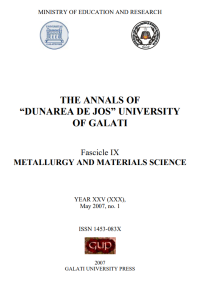Modelling and Prediction in Failure Processes by Mechanical Stresses in Corrosive Environment
Abstract
The complex interaction effect of mechanical stress- mechanical systems and aggressive environment, leads, at dramatic decreasing of their durability and reliability. The analyze of physical-chemical processes such as: electrode potential evolution, anodic current density evolution, size evolution and growing speed of cracks, allow finding common characteristics of failure due to mechanical stress combined with aggressive environment. Based on the analyze of failure mechanisms by stress cracking corrosion (monotonic mechanical loading), fatigue corrosion (cyclic mechanical loading) and tribocorrosion the paper authors suggest a global model of this kind of failure, based on degradation process of stress cracking corrosion with capability to realize a prediction of damage by these processes.
Downloads
References
[2]. Tribonod, B., 2004, A model for anodic dissolution cell in connection to its dimensions for stress corrosion cracking, Corrosion Science, 46, p. 2715-1741.
[3]. Engelhardt, G., Macdonald, D.D., Zhang Y, Dooley, B., 2004, Power Plant Chem., 6, p. 647.
[4]. Mc. Cartney, L.N., 1979, Int. Jour. Fracture, 15, 477-479.
[5]. Turnbull, A., McCartney, L.N., Zhou, S. 2006, A model to predict the evoluation of pitting corrosion and the pit-to-crack transition incorporating statistically distributed input parameters, Corrosion Science, 48, p. 2084-2105.
[6]. Kondo, Y., 1989, Corrosion, 45, p.7-11.
[7]. Gangloff, R.P. , 2002, Environment Sensitive Fatigue Crack Tip Processes and Propagation in Aerospace Aluminium Alloys, Fatigue 02, Ed. Engineering Material Advisory Services, West Midlands, UK, p. 3401-3433.
[8]. Palaghian, L., Bîrsan, I. G., 1999, Solicitări mecanice ale oţelurilor în medii corosive, Ed. Tehnică, Bucureşti.
[9]. Petrov, L.N., 1990, O mehanizme korrozionogo etapa razvitia trescin, Fiziko-himicashaia mehanica materialov, no. 4, p. 308-309.
[10]. Bristoll, P., Roeleved, J.A. , 1978, Fatigue offshore structures: effect of sea water on crack propagation in structural steel. Proc. European Offshore Stell Research Seminar, Cambridge, P. VI/28-1-VI/18-10.
[11]. Ford, F.P., 1992, Environmental assisted cracking of low alloy steels, EPRI NP-7473-L.
[12]. Norton, F.L., 1962, Hydrogen in steel, Pergamon Press, Oxford.
[13]. Cracknell, A., 1976, The effect of hydrogen on steel. Chem. Eng. (Gr. Brit) no. 306, p. 92-94.
[14]. Peng, Q, J., Know, J., Shoji, T., 2004, Development of a fundamental crack tip strain rate equation and its application to quantitative prediction of stess corrosion cracking of strainless in high temperature oxygenated water, Journal of Nuclear Materials, 324, p. 52-61.
[15]. Speidel, M.O.,1979, Stress Corrosion Research, H. Arup and R.N. Parkins, Eds. Sijthoff & Noordhoff, Alphen den Rijn, Netherlands, p. 117-183.
[16[. Wei, R.P., Landes, J.D., 1969, Materials Research and Standards, vol. 9, p. 25-28.
[17]. Bucci, R.J., 1970, Environment Enhanced Fatigue and Stress Corrosion Cracking of a Titanium Alloy Plus a Simple Model for the Assesment of Environmental Influence on Fatigue Behaviour, Ph. D. dissertation, Lehigh University, Bethelem, P.A.
[18]. Chu, H.P. , 1974, Fatigue crack propagation in a 5456-H117 aluminium alloy in air and sea water. Trans ASME Ser.D, no. 4, p. 261-267.
[19]. Cizelj, L., Mavko, B., Opperman H.R., Brücker-Foit, 1995, Propagation of stress corrosion crack in steam generator tubes, Int. J. Pres, Ves, Piping, 62, p. 1-9.
[20]. Shi, P., Mahadevan, S., 2003, Corrosion fatigue and multiple site damage reliability analysis, International Journal of Fatigue, 25, p. 457-469.
[21]. Dolley, E.J., Wei, R.P., 1998, Importance chemically shortcrack-growth on fatigue life, Proceedings of the Second Joint NASA/FAA/DoD Conference on Aging Aircraft, Williamsburg, VA, p. 679-687.
[22]. Kaynak, C., Ankara, A., Boker, T.J., 1996, Effects of short cracks on fatigue life calculations. Int. J. Fatigue, 18(1), p. 25-31.
[23]. Shi, P., Mahadevan, S., 2001, Damage tolerance approach for probabilistic pitting corrosion fatigue life prediction. Eng. Fract. Mech, 68 (13), p. 1493-1507.
[24]. Celis, Ponthiaux, P., Wenger, F.,2006, Tribo-corrosion of materials: Interplay between chemical, electrochemical and mechanical reactivity of surfaces, Wear, 261, p. 939-946.
[25]. Palaghian L., Bucşă, M., 2002, Aspect regarding material failure due to tribocorrosion, The Annals of University, “Dunarea de Jos” of Galati, Fascicle VIII, Tribology, p. 11-16.
[26]. Palaghian, L., Ciortan, S., Bîrsan I.G.,2001, About Fatigue and Wear Damage in Corrosive Environment The Annals of Dunărea de Jos University of galati, Tribology, p. 3-8.
[27]. Kajdas, C., Harvey, SSK, Wilusz, E., 1990, Encyclopaedia of Tribology, Tribology Series, 15. Amsterdam, Elsevier, 1990, p. 7-76.
[28]. Stott, F.H., Kreakell, J.E., Newman, R.C., 1990, The corrosion wear of cast iron under potentiostatically-controlled conditions in sulphuric acid solutions. Corrosion Science, 30, p. 813-830.
[29]. Jiang, X.X., Li, S.Z., Tao, D.D., Yang, J.X., Accelerative effect of wear on corrosion of high-alloy stainless steel. Corrosion, 49, p. 836-841.
[30]. Leis, B.N., Rungta, R., Mayfield, M.E., Beavers, J.A., 1983, Corrosion system. Crooker T.W, Leis BN editors. Corrosion fatigue: mechanics, metallurgy, electrochemistry and engineering. ASTM STP 801, ASTM, p. 197-228.
[31]. Wei, R.P., Shim, G., 1983, Fracture mechanics and corrosion fatigue. In: Crooker TX, Leis BN editors. Corrosion fatigue: mechanics, metallurgy, electrochemistry and engineering. ASTM STP 801, ASTM, p. 5-25.
[32]. Jiang, J., Stack, M.M., Neville, A., 2002, Modelling the tribo-corrosion interaction in aqueous sliding conditions, Tribology International, 35, p. 669-679.
[33]. Jiang, J., Stack, M.M., 2006, Modelling sliding wear: From dry to wet environments, Wear 261, p. 954-965.
[34]. Johnson, K.L. , 1995, Contact mechanics, and the wear of metals, Wear, 190, p. 162-170.
[35]. Coffin, L.F., A study of the effect of cyclic thermal stresses on a ductile metal, Transactions of the American Society of Mechanical Engineers, 96, p. 931-950.



